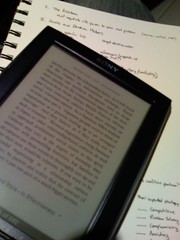
- Image by Terretta via Flickr
Last week, I posted about how easy it was to post and publish ebook versions of my new novel. It took very little time to publish this way, and I felt like I had much more control over the data.
On the same day as my Kindle version went live, I received the printed copies of my book.
And boy, did I ever like the printed versions.
A major area where ebooks fail is in aesthetics and craft. When you publish to an ebook, you publish to a platform or a device with inherent preferences and limitations. Your content conforms to the platform or device. You can’t make the iPhone bigger or textured or embossed. On the Kindle, there is no color.
Your cover vanishes.
The font is the default font.
And so on.
But aesthetics matter. Publishers lavish their attention on the covers of their books. Interior layouts and font choices can make the reading experience more immersive, adding an important pleasure to consuming the author’s thoughts or the story.
As the author of “Marketing Aesthetics” puts it:
Aesthetics is not esoteric. The vitality of aesthetics in customers’ lives provides opportunities for organizations to appeal to customers through a variety of sensory experiences
The smells, textures, colors, surfaces, shapes, and weights of beautifully wrought physical objects still matter. Smells trigger memories, touch locks in the senses. A digital reader might itself be a beautiful object, but it transfers little to the content presented on it while shutting out attempts to craft a unique reading experience.
This is the frontier digital devices have yet to cross. Will they? Can they?
Will the human propensity for craft find a place in the emerging digital world?
Discussion
4 Thoughts on "Craft, Control, and Aesthetics = Print"
I still think the coolest thing about being in publishing is going to a printing plant. ANd the happiest days are the days the books (or journals) arrive.
This from someone whose entire career has been in electronic publishing.
BRAVO, Kent! Although I’m known mainly as an XML evangelist (and I am one), I’m actually a typographer at heart and have been designing books (mostly for fun–never made my living at it) for 35 years. My office is full of typographic broadsides (including Bruce Rogers’ legendary Centaur broadside, one of the true masterpieces of typography of all time–no kidding, it is a single sheet of paper that is truly thrilling to a type geek, indisputably a work of genius). BUT, the most important point I want to make is that XML and typography can, and should, go hand-in-hand. There is absolutely no reason to think that embracing current technology–specifically XML–should in any way limit your ability to design and produce beautiful pages. In fact, it enables you to make them _as beautiful as possible in each given environment_: composing excellent print pages, providing those lovely pages as PDFs, and ALSO rendering them in the best possible way online or in e-books (which, by the way, should generally NOT try to emulate the print pages too literally). One final thought: great typography is not generally show-offy typography. Another typographic master, Stanley Morison (designer of the now ubiquitous Times New Roman font) said “The primary aim of printing is not to be an art, but to be the most responsible of our social, industrial, and intellectual mechanisms; it must, like a transport system, be most disciplined, most rational. Nevertheless, if it is allowable to define art, in this connection, as THE APPLICATION OF KNOWLEDGE, REASON, AND SKILL TO THE SERVICE OF WRITERS AND READERS [emphasis mine], it may not be rash to hope that some of the past, present, and future productions of the printer will, as multiplied productions of reason and skill, be counted worthy to rank as an Aspect of Art.” I would offer that his sentiments now apply to ALL modes of publishing, whether print or electronic.–Bill Kasdorf
![Reblog this post [with Zemanta]](http://img.zemanta.com/reblog_e.png?x-id=93c63775-9df1-4abb-a35f-ae6363105c3a)


